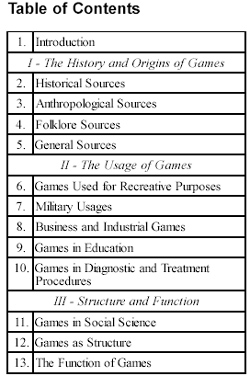 Elliott M. Avedon & Brian Sutton-Smith
Elliott M. Avedon & Brian Sutton-Smith
Robert E. Krieger Publishing Co., Inc.,
645 New York Avenue,
Huntington, New York 11743
First edition 1971, reprinted 1979
ISBN 0-89874-045-2
Introduction
“The Study of Games represents the collaboration of two game buffs who, much to their mutual surprise, found their range of understanding and their knowledge of this subject matter much extended by interdisciplinary contact. The authors (coming from the fields of recreation and psychology) assume that others from such divergent fields as business, anthropology, education, psychiatry, folklore, military science, might profit also from a similar crossdisciplinary experience.
The present work is a general reference manual of representative readings and comprehensive bibliographies developed from excursions into many different disciplines.”
Commentary
This is not a book for the faint of heart. It is, first and foremost, a scholarly treatise with all of the bibliographies, footnotes and referential nuances, and none of the pretty pictures, entailed by such things. It is also a history, not of games, but of gaming and game theory. And finally, it is unfortunately somewhat dated.
“[T]he increased interest in games in the late eighteenth and early nineteenth centuries is usually said to have been associated with an emerging interest in antiquarianism in the scholarship of that period, with romanticism in literature, and with increasing urbanization in the sociopolitical world. As there has been little or no scholarship on the history of game scholarship itself, however, these statements must remain, at best, generalized guesses.”
“As far as we can judge, war games were exercises in physical skill and strategy. In their earliest formalizations in Western culture they seem to have been mixtures of geometry and chess. During the eighteenth century: ‘The tactical and strategical writings of that epoch had, for the greeater part, an outlandish resemblance to a course in geometry; a true strategist of that epoch did not know how to lead a corporal’s guard across a ditch without a table of logarithms.’”
Helwig, a master of pages in the Court of the Duke of Brunswick, has been credited with the idea of using a game to teach military tactics, in 1780. “The first thought which presented itself to my mind was that the learning of my game ought not to be burdened with too many details if it was to fulfill its mission.” Clearly, it was the first of many, many thoughts, and got lost somewhere between the game board of 1666 squares, and the depiction of different terrains for each square with various colors and color combinations. To this day, presumably in honor of the Helwig tradition, game designers start with the best of intentions and end with encyclopedic rulebooks. William R. Livermore’s war game, The American Kriegsspiel, published in 1898, is credited with three significant features:
- systematic numerical factors to evaluate engagements based on past events;
- an allowance for psychological factors, such as morale; and,
- the use of Monte Carlo methods (an elementary Monte Carlo method is the throwing of dice) to assess the effect of fire.
These are not unfamiliar features to modern board wargamers, and are in fact almost taken for granted, yet it is surprising how few military war games developed in the first half of the twentieth century employed more than the third feature.
One might expect that military war games and board wargames would share many similarities, so much so that they would actually be indistinguishable. The fact that they do not, as a matter of course, boils down to the difference in attitude towards gaming. When a dog chases a rabbit, the dog is running for its meal, but the rabbit is running for its life.
Back to Simulacrum Vol. 4 No. 3 Table of Contents
Back to Simulacrum List of Issues
Back to MagWeb Master Magazine List
© Copyright 2002 by Steambubble Graphics
This article appears in MagWeb (Magazine Web) on the Internet World Wide Web. Other articles from military history and related magazines are available at http://www.magweb.com